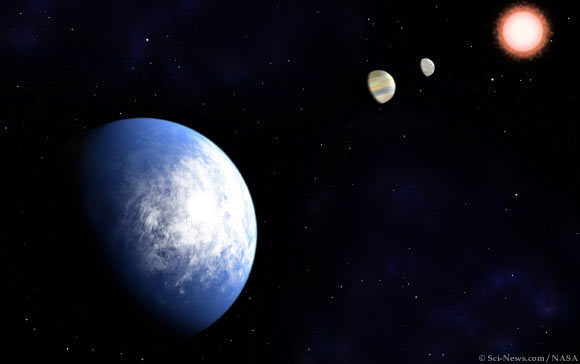Using NASA’s Transiting Exoplanet Survey Satellite, the agency’s Spitzer Space Telescope and other facilities, astronomers have discovered a compact system of three small planets orbiting around the cool M-dwarf star TOI-700. One of these planets, named TOI-700d, has a radius of 1.1 times that of the Earth and orbits within the conservative habitable zone of its host star.
Source: Sci News
TOI-700 is located approximately 102 light-years away in the constellation of Dorado.
The star is roughly 40% of the Sun’s mass and size and about half its surface temperature.
Otherwise known as UCAC3 49-21611 and 2MASS J06282325-6534456, it hosts at least three exoplanets: TOI-700b, c and d.
The planets are tidally locked to the star, which means they rotate once per orbit so that one side is constantly bathed in daylight.
The innermost planet, TOI-700b, is almost exactly Earth-size, is probably rocky, and completes an orbit every 10 days.
TOI-700c is a gas giant about 2.6 times the size of Earth, and orbits the parent star once every 16 days.
The outermost planet, TOI-700d, is 1.1 times the size of Earth, and has an orbital period of 38 days.
It lies within its star’s habitable zone, receives from the star 86% of the energy that the Sun provides to Earth, and has a surface temperature of minus 3 degrees Celsius (26 degrees Fahrenheit).
The planets were discovered in TESS data by University of Chicago graduate student Emily Gilbert and her colleagues.
“TOI-700 hosts several small planets and is ideal for mass measurements using precision radial velocity follow-up,” the astronomers said.
“The planets are also interesting targets for transit spectroscopy observations to place constraints on their atmospheres.”
“This system and other discoveries from the first year of TESS observations fulfill the mission’s goal of identifying new exoplanets prime for detailed follow-up and provide a positive outlook for TESS’s second year and extended mission observations.”
In a separate study, Dr. Samuel Quinn, an astronomer at the Center for Astrophysics at Harvard & Smithsonian, and colleagues used Spitzer to confirm the existence of TOI-700d.
“Given the impact of this discovery — that it is TESS’s first habitable-zone Earth-size planet — we really wanted our understanding of this system to be as concrete as possible,” said Dr. Joseph Rodriguez, also from the Center for Astrophysics at Harvard & Smithsonian.
“Spitzer saw TOI-700d transit exactly when we expected it to. It’s a great addition to the legacy of a mission that helped confirm two of the TRAPPIST-1 planets and identify five more.”
While the exact conditions on TOI-700d are unknown, astronomers can use current information to make predictions.
Dr. Gabrielle Engelmann-Suissa, a Universities Space Research Association visiting research assistant at NASA’s Goddard Space Flight Center, and her colleagues modeled the planet in the habitable zone of an M-dwarf star over a wide range of possible atmospheric conditions.
“Our 3D climate models examined a variety of surface types and atmospheric compositions typically associated with what scientists regard to be potentially habitable worlds,” they explained.
“Because TOI-700d is tidally locked to its star, the planet’s cloud formations and wind patterns may be strikingly different from Earth’s.”
“One simulation included an ocean-covered TOI-700d with a dense, carbon-dioxide-dominated atmosphere similar to what scientists suspect surrounded Mars when it was young. The model atmosphere contains a deep layer of clouds on the star-facing side.”
“Another model depicts TOI-700d as a cloudless, all-land version of modern Earth, where winds flow away from the night side of the planet and converge on the point directly facing the star. When starlight passes through a planet’s atmosphere, it interacts with molecules like carbon dioxide and nitrogen to produce distinct signals, called spectral lines.”
The scientists also produced simulated spectra for the 20 modeled versions of TOI-700d.
“Someday, when we have real spectra from TOI-700d, we can backtrack, match them to the closest simulated spectrum, and then match that to a model,” Dr. Engelmann-Suissa said.
“It’s exciting because no matter what we find out about the planet, it’s going to look completely different from what we have here on Earth.”
The three teams of astronomers presented their results this week at the 235th Meeting of the American Astronomical Society in Honolulu, Hawai’i.
Source: Sci News

































Leave a Comment
You must be logged in to post a comment.